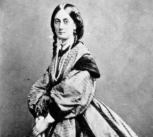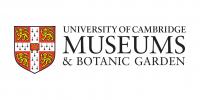What’s in the collection?
Two fossil bones of the giant extinct wombat-relative, Diprotodon. (Specimens A11. 5/1 and A11. 5/3).

When did it arrive?
August 1887
What do we know about the specimens in Cambridge?
It’s a story of colonial networks. Bowen most likely acquired them during her husband George Bowen’s governorship of Queensland, between 1859 and 1868, probably as gifts. She then took them to New Zealand during his governorship there. She entrusted them to the writer George Kingsley (see below) during his visit there around 1870/71, asking him to “present them to a museum. Cambridge for preference.” However Kingsley held on to them until 1887, when he offered them to the University Museum of Zoology. Had they reached taxonomists soon after their collection, they would have represented a relatively early example of Diprotodon material (the species was first described by Richard Owen in 1838). Kingsley described them as “a gigantic fossil Kangaroo” (Ref. 1), suggesting that possibly Bowen had done the same.
A skeleton of Diprotodon appeared prominently in the International Exhibition of 1873 in London, in the Queensland Annexe – alongside displays of the principal extractive productions of the colony (gold, cotton, sugar, tobacco) – as an advert to encourage people to emigrate.
Who was Diamantina Bowen?

She was an aristocrat and public figure who established several charitable foundations, including hospitals.
She lived in several British colonies, because her husband George Bowen was posted as Governor in five different locations, including as the first Governor of Queensland.
Contessa Diamantina Bowen (née Roma) was born in the United States of the Ionian Islands (Zante or Corfu) in 1832 or 1833, descended from Venetian aristocracy during their occupation of the Ionian Islands. Almost every line of her biography is steeped in colonial connections. At the time of her birth, the islands were a British Protectorate (from 1815 to 1864). Her father was president of the Corfiot Senate and titular head of the Ionian Islands Republic. She married George Bowen, the British Chief Secretary of Government to the Ionian Islands on 28/04/1856 (he was knighted twelve days later). Sir John Young – Lord High Commissioner of the Ionian Islands and subsequently Governor of New South Wales – was a signatory at their wedding.
Sir George was appointed the Queensland’s first Governor and in 1859 they moved to Brisbane (arriving 10th December – when he read a proclamation which officially claimed Queensland as a separate self-governing colony from New South Wales). He was in post until January 1868. They were sent off fondly by the settler colonist community when they left Brisbane, with several gifts made to Lady Bowen.
Sir George subsequently became Governor of New Zealand (1868-1873), Victoria (1873-1879), Mauritius (1879-1883) and Hong Kong (1883-1887), before returning to England. Diamantina followed him throughout, and much of her biographical accounts discuss her active role in the social lives of the colonies’ gentry.
In Brisbane she also made significant charitable municipal contributions, founding the Lady Bowen Lying-In Hospital – Brisbane’s first maternity hospital – which still exists as Royal Brisbane Women's Hospital; the Diamantina Home for Incurables and the Diamantina Orphanage. She has several geographical features, roads and areas named after her (e.g., Diamantina River, and its subsequent national park), including using her maiden name Roma.
Research from the Colonial histories of Australian mammal collections in Cambridge project has not uncovered any evidence Lady Bowen had an interest in natural history, and no other specimens of hers can be located in other natural history museums – these fossils in Cambridge appear to be her only natural historical contribution. She is said to have collected objets d’art, including Chippendale furniture and Netsuki carvings.
Who was George Kingsley?
George Henry Kingsley was a doctor, traveller and writer. The 1872 travelogue South Sea Bubbles detailed his 1867-1870 voyage to Polynesia with George Herbert, the Earl of Pembroke, and was highly successful.
South Sea Bubbles is a very purple narrative full of “ohs!” and “woahs!”, apparently written in the first person by the Earl of Pembroke. It describes in detail the wreck of their ship the Albatross in October 1870 near Fiji on their way to New Zealand (presumably when they then met the Bowens), and that they lost an important collection of bird skins. It makes no mention of the Bowens. There are a number of problematic passages that, for example, objectify Samoan women and assume that all Fijians are cannibals.

Further Reading
Hugh Gilchrist, 'Bowen, Diamantina (1833–1893)', Australian Dictionary of Biography, National Centre of Biography, Australian National University, https://adb.anu.edu.au/biography/bowen-diamantina-12812/text23125, published first in hardcopy 2005, accessed online 27 January 2023.
References
1. University Museum of Zoology, Cambridge. Archive V2.361. Letter from Kingsley to John Wills Clarke 06.07.1887





